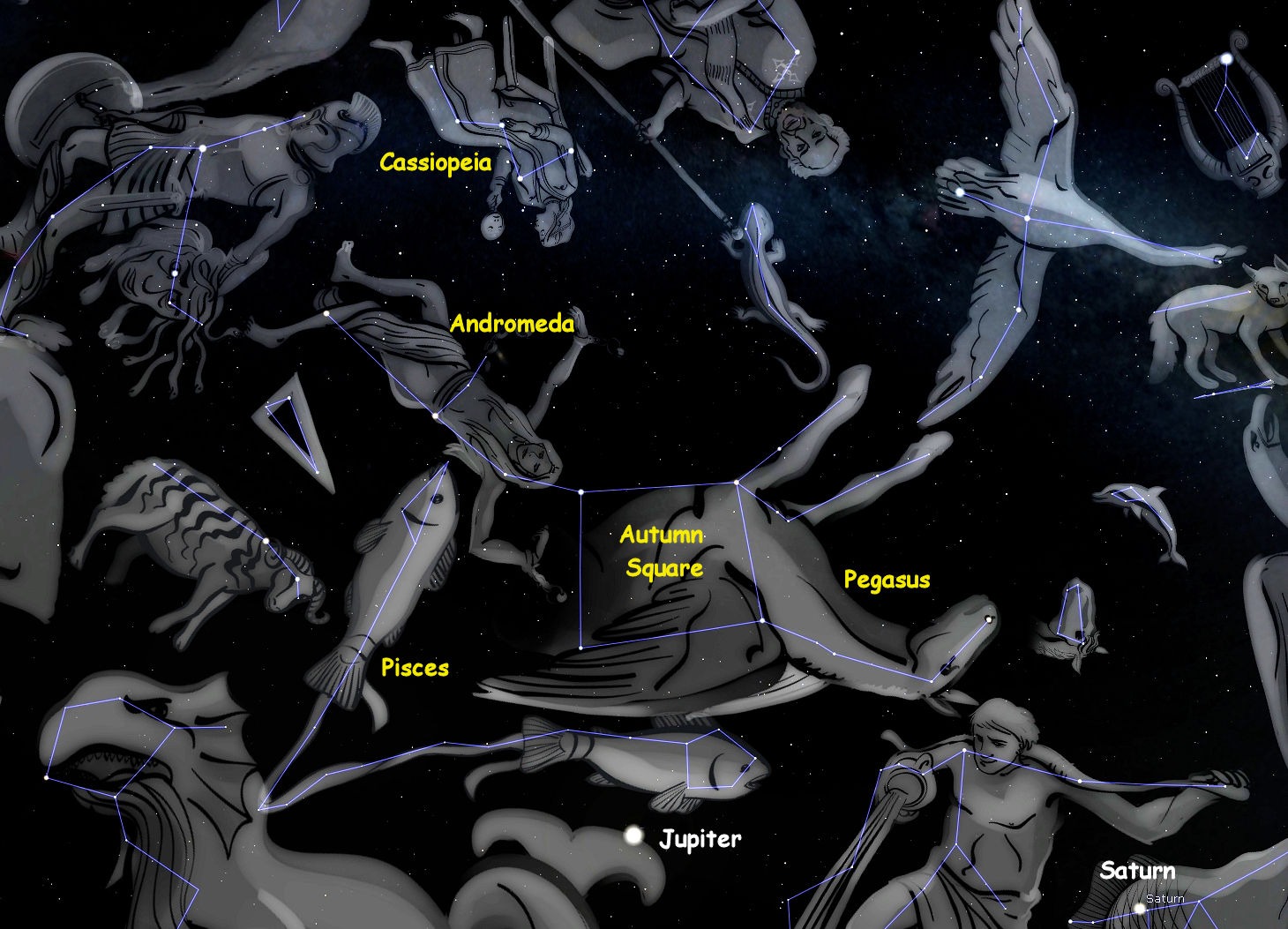Autumn Sky
As summer fades into our memories, we look forward to the dark autumn sky.
This year three planets underline the autumn stars.
Mars, Jupiter and Saturn line up from east to west.
Above the row of planets are the autumn constellations.
We’ll pick out the best of them in this blog.
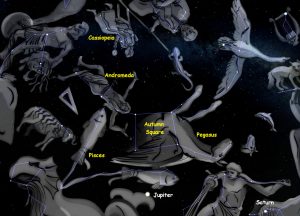
Autumn sky, looking South. Stellarium
The daytime sky also welcomes an uncommon astronomical event.
On October 26th, there will be a partial eclipse of the Sun.
In this blog, we’ll reveal a way of safely showing the eclipse to family and friends.
Stellarium star maps.
As usual, our views of the night sky come by courtesy of Stellarium.
Stellarium gives a superb rendition of the night sky on a PC, tablet or smart phone.
We can see the sky at any time on any date of any year.
It’s the software we use in Wonderdome Planetarium.
And it’s free to use! Download it here at Stellarium.
The Autumn Square
As ever, the seasonal constellations are in the southern sky.
Jupiter glows in the south, brighter than any of the stars.
The giant planet is a good starting point for our autumn constellation tour.
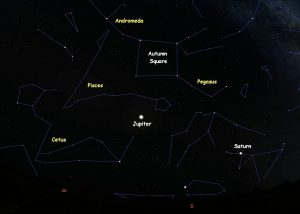
Autumn sky looking South, with constellations marked. Stellarium
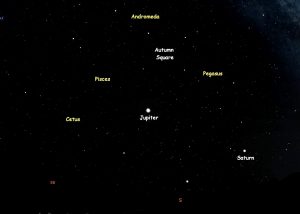
Autumn sky looking South. Stellarium
Above Jupiter, we see a large square of stars.
This is the Autumn Square, the Square of Pegasus.
To the lower right, other stars make the neck and head of the mythical flying horse.
A line of stars to the top left represents the body of Andromeda, the princess.
Hidden in plain sight there is the Andromeda Galaxy, M31.
This galaxy will be the focus of our next blog.
Just to whet your appetite, here’s the latest image of M31.
New Image
In June, NASA and ESA published an entirely new view of the familiar galaxy.
They combined images from space telescopes and ground instruments.
These telescopes covered a range of the spectrum from microwave to radio wavelengths.
Here is the resulting image.
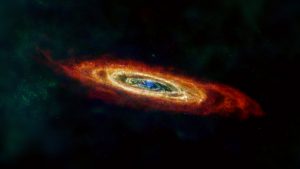
Credits: ESA/NASA/JPL-Caltech/GBT/WSRT/IRAM/C. Clark (STScI)
Red in the image shows hydrogen gas, green is cold dust and blue is warmer dust.
Back in our autumn sky, we look above Andromeda.
Overhead, we see a distinctive letter ‘W’ of stars.
This is the throne of Andromeda’s mother, Queen Cassiopeia.
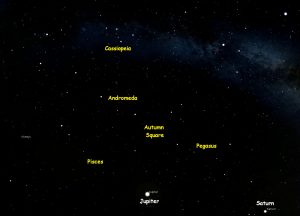
Autumn sky looking South to overhead. Stellarium
Autumn Planets
We featured the autumn planet parade in a recent blog.
Saturn is low in the West.
With a small telescope, you can resolve its beautiful rings.
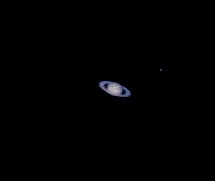
Saturn, small telescope. Photo: Dennis Ashton
Jupiter shines brightly in the Southern sky.
With a telescope or binoculars you may see cloud bands and the four big moons.

Jupiter and moons, small telescope. Photo: Dennis Ashton
Mars is low in the East.
A telescope shows dark markings on the surface of the red planet.
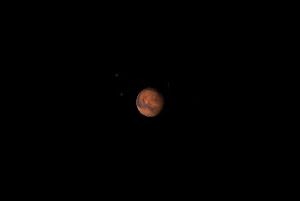
Mars, small telescope. Dennis Ashton
Shooting Stars
Around October 21st / 22nd, there is a display of shooting stars.
They are the Orionid meteors, so called because they emanate from the constellation of Orion.
Because Orion rises late at night, most meteors will be seen after midnight.
They shoot across the sky from the East.
To be honest, we are unlikely to see many Orionids.
Ten in an hour would be a good score.
The Orionids have historical interest.
They come from dust particles left by Halley’s Comet.
The Moon and planets
As the Moon ambles through our sky, it moves in front of the planets.
It passes below Saturn on October 5th and moves on to Jupiter on the 8th.
By October 14th, the Moon sits near Mars.
Partial Solar Eclipse
The Moon features in our daytime sky too.
On October 25th, our Moon takes a bite out of the Sun, a partial solar eclipse.
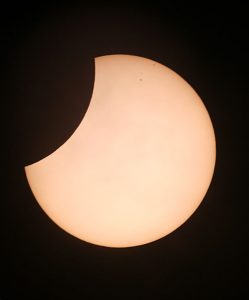
Partial Solar eclipse simulation.
The eclipse starts just after 10am in the UK.
The maximum eclipse is just before 11am.
Then the Moon covers about a quarter of the Sun’s disc.
The show is over a few minutes before noon.
Times vary a little dependent on where you are in the UK.
Viewing the eclipse safely
You should never view the sun directly.
Doing so can permanently damage your vision.
Here are two ways to safely view the event.
Both use an image projected onto white card.
The second method is really neat!
You can show a big image to lots of people.
The equipment you need is already in your home.
You can assemble your eclipse viewer in a few minutes.
Like me, you can test your Sun projector on any sunny day before the eclipse.
Then you’ll be ready to go on October 25th.
Method 1
This uses ‘pinhole projection’
First make a small hole in a piece of card.
I actually used a poster tube. The hole was in the plastic cover.
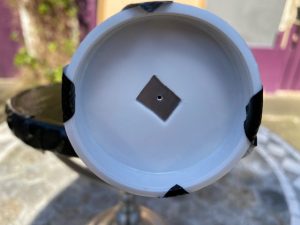
Pinhole projector. Photo: Dennis Ashton
Use the card to create a shadow for the image.
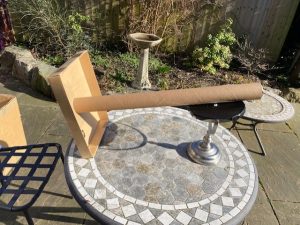
Point the pinhole towards the Sun.
A small image of the Sun will project onto the white card screen.
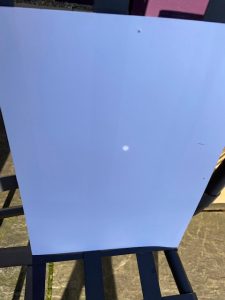
Method 2
The pinhole projection makes a very tiny image.
But our second projection can show the eclipse to a crowd of people!
The Mirror
You will need an ordinary flat mirror.
I used the flat side of a bathroom mirror because it is easily tilted.
Next cut a hole in some card about 5 millimetres square.
Then stick the card to the mirror with the hole in the middle.
I actually used gaffer tape to cover the mirror.
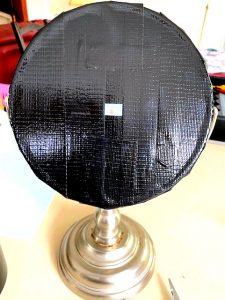
Flat mirror with 5mm hole at centre.
The Screen
Next, go outside and fasten a piece of white card to a wall in the shade.
This is our projection screen.
Position the mirror in sunlight around 6 to10 metres from the screen.
Then angle the mirror so that it reflects an image of the Sun onto the card screen.
You will create an image of the Sun large enough for several people to view at the same time.
It will be good enough to photograph the eclipse as it develops.
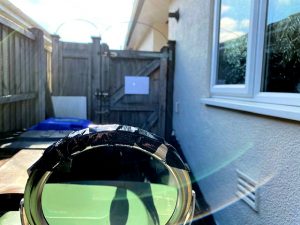
Mirror Sun projector. Dennis Ashton
In the photo above, the mirror is near the camera.
You can see in the background the Sun’s image projected on the card screen attached to the gate.
Below is a photo of the image.
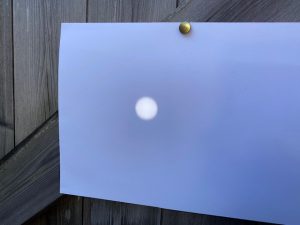
You can make the image bigger by moving the mirror further away.
Although the image then becomes dimmer, you’ll find the best set up for you.
Back in the 1990s we had a similar partial eclipse.
I organised an event in Sheffield City Centre with the aid of Hallam University.
Professor John Parkinson demonstrated the mirror projection by projecting an image onto a white stone building.
Around 250 people saw the eclipse by this clever projection!
The author: Dennis Ashton is a Fellow of the Royal Astronomical Society and a Wonderdome presenter.
Would you like to hear more Astronomy news?
Do you want to to find out about our upcoming public events?
Follow WonderDome Portable Planetarium on Twitter and Facebook or go to our web site wonderdome.co.uk!

